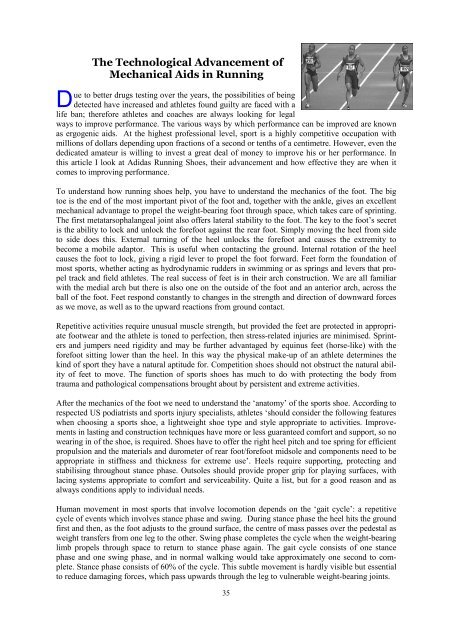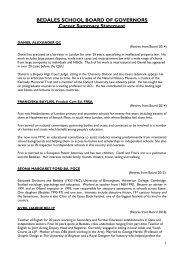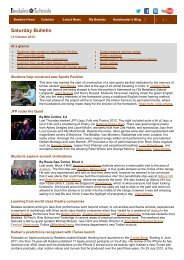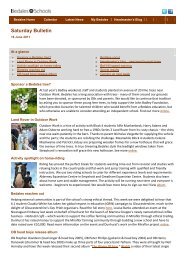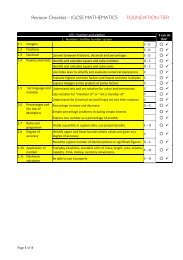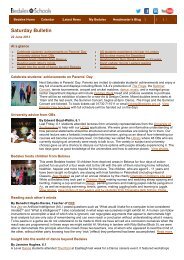You also want an ePaper? Increase the reach of your titles
YUMPU automatically turns print PDFs into web optimized ePapers that Google loves.
The Technological Advancement ofMechanical Aids in Runningue to better drugs testing over the years, the possibilities of beingD detected have increased and athletes found guilty are faced with alife ban; therefore athletes and coaches are always looking for legalways to improve performance. The various ways by which performance can be improved are knownas ergogenic aids. At the highest professional level, sport is a highly competitive occupation withmillions of dollars depending upon fractions of a second or tenths of a centimetre. However, even thededicated amateur is willing to invest a great deal of money to improve his or her performance. Inthis article I look at Adidas Running Shoes, their advancement and how effective they are when itcomes to improving performance.To understand how running shoes help, you have to understand the mechanics of the foot. The bigtoe is the end of the most important pivot of the foot and, together with the ankle, gives an excellentmechanical advantage to propel the weight-bearing foot through space, which takes care of sprinting.The first metatarsophalangeal joint also offers lateral stability to the foot. The key to the foot’s secretis the ability to lock and unlock the forefoot against the rear foot. Simply moving the heel from sideto side does this. External turning of the heel unlocks the forefoot and causes the extremity tobecome a mobile adaptor. This is useful when contacting the ground. Internal rotation of the heelcauses the foot to lock, giving a rigid lever to propel the foot forward. Feet form the foundation ofmost sports, whether acting as hydrodynamic rudders in swimming or as springs and levers that propeltrack and field athletes. The real success of feet is in their arch construction. We are all familiarwith the medial arch but there is also one on the outside of the foot and an anterior arch, across theball of the foot. Feet respond constantly to changes in the strength and direction of downward forcesas we move, as well as to the upward reactions from ground contact.Repetitive activities require unusual muscle strength, but provided the feet are protected in appropriatefootwear and the athlete is toned to perfection, then stress-related injuries are minimised. Sprintersand jumpers need rigidity and may be further advantaged by equinus feet (horse-like) with theforefoot sitting lower than the heel. In this way the physical make-up of an athlete determines thekind of sport they have a natural aptitude for. Competition shoes should not obstruct the natural abilityof feet to move. The function of sports shoes has much to do with protecting the body fromtrauma and pathological compensations brought about by persistent and extreme activities.After the mechanics of the foot we need to understand the ‘anatomy’ of the sports shoe. According torespected US podiatrists and sports injury specialists, athletes ‘should consider the following featureswhen choosing a sports shoe, a lightweight shoe type and style appropriate to activities. Improvementsin lasting and construction techniques have more or less guaranteed comfort and support, so nowearing in of the shoe, is required. Shoes have to offer the right heel pitch and toe spring for efficientpropulsion and the materials and durometer of rear foot/forefoot midsole and components need to beappropriate in stiffness and thickness for extreme use’. Heels require supporting, protecting andstabilising throughout stance phase. Outsoles should provide proper grip for playing surfaces, withlacing systems appropriate to comfort and serviceability. Quite a list, but for a good reason and asalways conditions apply to individual needs.Human movement in most sports that involve locomotion depends on the ‘gait cycle’: a repetitivecycle of events which involves stance phase and swing. During stance phase the heel hits the groundfirst and then, as the foot adjusts to the ground surface, the centre of mass passes over the pedestal asweight transfers from one leg to the other. Swing phase completes the cycle when the weight-bearinglimb propels through space to return to stance phase again. The gait cycle consists of one stancephase and one swing phase, and in normal walking would take approximately one second to complete.Stance phase consists of 60% of the cycle. This subtle movement is hardly visible but essentialto reduce damaging forces, which pass upwards through the leg to vulnerable weight-bearing joints.35


